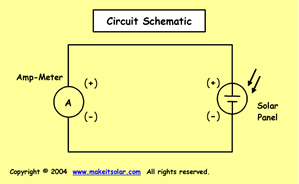Wavelength of Light that hits a Solar Panel
Solar cells generate an electrical current when light hits their surface. White light that we see from the Sun includes all colors of the visible spectrum and ranges in wavelength from about 400 nanometers (nm) to about 780 nm. Solar cells vary in their response to different wavelengths, or color, of light.
Color and Wavelength of Light
Wavelength (nm)
Currently available solar cells respond well to some, but not all, wavelengths. There is continuing research to develop solar cells that will respond well to the largest range of wavelengths as possible.
If you are under 18 years old, get permission from an adult to do this experiment.
Science Fair Project Idea/ Objective:
To demonstrate how a solar cell responds differently to different wavelengths of light. You will develop this idea by covering the solar cell with color light filters and observing any changes in solar cell amperage output.
Hypothesis:
A solar panel will output different levels of power depending on the color and wavelength of the incoming light.
Materials:
- Solar Panel
- Multi-meter to measure Milli-Amps.
- Paper and pencil
- Color Filters (violet, blue, green, yellow, orange, red) - you can use cellophane or a similar material. I have also used colored plastic tabs for hanging folders.
Schematic: (large image)

Set Up:
- Make a set of color filters that will be easy to handle. They should be made to cover the solar panel completely.
- Find a sunny spot outside.
- Connect the ammeter to the solar panel and set the solar panel on a flat surface. Set the ammeter output so that it will read milli-amps (mA).
Procedure
- Print out this work sheet or make your own.
- Set up your equipment.
- Lay the solar panel on a surface so that it is facing straight at the Sun and keep it in the same position for all of your testing. Use a block of wood or rock if necessary.
- Begin your testing by measuring the output of the solar cell in full sun without filters. Record the mA reading from your ammeter.
- Test each color filter by covering the solar cell. Each time record the color and the mA reading from your ammeter.
- Record the results in the worksheet and answer the questions.
Expected Results:
You should see changes in the solar cell output depending on the color filter that you use.
In general, with this experiment, you will only be able to prove that “The output power of a solar panel will change with the color (wavelength) of incoming light”. To prove and explain more than that requires high-school to college level physics.
Keep in mind that you may see linear trends and you may not. It depends on the type of solar cell you have. Different solar cells are designed to operate efficiently at different wavelengths depending on the materials used to manufacture them. Research in the area of solar cells continues with an interest to develop cells that will operate at the widest range of wavelengths.
Cellophane Hint
If you have clear cellophane and color markers can make your own. You might even try printing onto a sheet of overhead transparency. If you have shown a difference among 3 to 4 different colors then you have proven the hypothesis. Additional work with all colors may be “nice to have” but not necessary. A teacher may be able to give you good feedback on how many colors you need to test.
Further Reading:
See for example this project The Effect of Wavelength of Visible Light on Photovoltaic Cell Electricity Generation by Christina Zhu for the California State Science Fair.
Try This:
Find other items to use as filters such as parchment paper, wax paper, glass, plastic food wrap, cardboard, plastic shopping bag, etc. Which ones block the sunlight and which ones allow some sunlight to pass through?